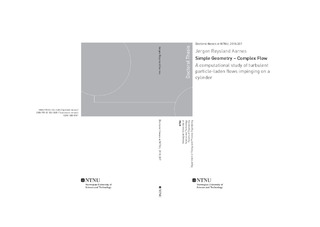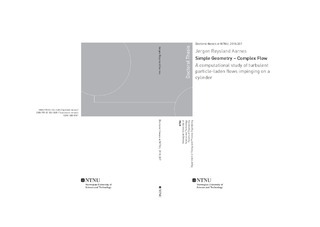| dc.contributor.advisor | Andersson, Helge Ingolf | |
| dc.contributor.author | Aarnes, Jørgen Røysland | |
| dc.date.accessioned | 2018-11-09T13:20:52Z | |
| dc.date.available | 2018-11-09T13:20:52Z | |
| dc.date.issued | 2018 | |
| dc.identifier.isbn | 978-82-326-3405-7 | |
| dc.identifier.issn | 1503-8181 | |
| dc.identifier.uri | http://hdl.handle.net/11250/2571850 | |
| dc.description.abstract | Direct numerical simulations were performed to study the effects of free-stream turbulence on different flow regimes past a circular cylinder. The focus was on the transition-in-wake state of the flow and particle impact on the cylinder. To increase accuracy of the simulations, a considerable effort was made to improve the numerical methods used within the simulations. The focus of these improvements was on an existing immersed boundary method and a newly developed overset grid method for the representation of the solid cylinder in the open-source Pencil Code.
Transition-in-wake is the first stage of transition to turbulent flow around a cylinder, and can be characterized by three-dimensional effects developing in the wake, along with a decrease in the vortex shedding frequency (at Re = 190). For medium to high-intensity turbulent free-stream flow, the Reynolds number bandwidth for transition is increased. That is, the transition is initiated at a lower Reynolds number and endures to a higher Reynolds number than when the free-stream is laminar.
Relevant mechanisms for this bandwidth increase include intermittent vortex dislocations and quasi-stable states at lower Reynolds numbers within the transition, and stimulations of larger modes of instabilities for higher Reynolds numbers.
For inertial particle impaction on a cylinder at moderate Reynolds number (Re = 100 and Re = 400), high-intensity free-stream turbulence significantly amplifies the number of particles that impact the cylinder (for certain particle Stokes numbers,St). The peak amplification of impaction is observed at St = 0:3. This peak is related to a change in impaction mechanism, from boundary stopping to boundary interception, and it will therefore dependent on the size of the particles as well as the
Stokes number. The amplification decreases rapidly when the difference between a particle’s Stokes number and Stokes number at peak impaction increases. These observations were reproduced from laminar impaction data using an expression for expectation value to estimate the particle impaction within the turbulent free-stream.
Improving how ghost- and mirror-points reconstruct the boundary conditions in an existing immersed boundary method yielded a more efficient way to perform simulations of a cylinder in a cross-flow using the Pencil Code. Yet impaction of small particles proved computational costly, limiting St 0:2. Overset grids were developed as a means to overcome this limitation. The overset grid implementation uses sixth-order finite-differences for the governing equations, with summation-bypart operators at the boundary, Padé filtering and local time-step restrictions. The result is high-order accuracy at the cylinder boundary reproducing particle impaction with a 90% reduction in the necessary grid points. For 2D flow simulations, the number of grid points could be reduced by factors of 14–18 for flows with Re=100–400 when using overset grids rather than the immersed boundary method. | nb_NO |
| dc.language.iso | eng | nb_NO |
| dc.publisher | NTNU | nb_NO |
| dc.relation.ispartofseries | Doctoral theses at NTNU;2018:307 | |
| dc.relation.haspart | Paper 1: Aarnes, Jørgen Røysland; Haugen, Nils Erland L; Andersson, Helge Ingolf. On validation and implementation of an immersed boundary method in a high order finite difference code for flow simulations. I: Proceedings of MekIT'15 Eighth National Conference on Computational Mechanics. International Center for Numerical Methods in Engineering (CIMNE) 2015 s. 1-21 | nb_NO |
| dc.relation.haspart | Paper 2: Aarnes, Jørgen Røysland; Andersson, Helge Ingolf; Haugen, Nils Erland L. Numerical investigation of free-stream turbulence effects on the transition-in-wake state of flow past a circular cylinder. Journal of turbulence 2018 ;Volum 19.(3) s. 252-273
https://doi.org/10.1080/14685248.2017.1418085 | nb_NO |
| dc.relation.haspart | Paper 3: Inertial particle impaction on a cylinder in a turbulent cross-flow at modest Reynolds numbers.
Accepted in International Journal of Multiphase Flow
© 2018 This manuscript version is made available under the CC-BY-NC-ND 4.0 license http://creativecommons.org/licenses/by-nc-nd/4.0/ | nb_NO |
| dc.relation.haspart | Paper 4: High-order overset grid method for detecting particle impaction on a cylinder in a cross flow | nb_NO |
| dc.relation.haspart | Paper 5: Aarnes, Jørgen Røysland; Jin, Tai; Mao, Chaoli; Haugen, Nils Erland L; Luo, Kun; Andersson, Helge Ingolf. Treatment of solid objects in the Pencil Code using an immersed boundary method and overset grids. Geophysical and Astrophysical Fluid Dynamics 2018 s. 1-24
https://doi.org/10.1080/03091929.2018.1492720 | nb_NO |
| dc.title | Simple Geometry – Complex Flow A computational study of turbulent particle-laden flows impinging on a cylinder | nb_NO |
| dc.type | Doctoral thesis | nb_NO |
| dc.subject.nsi | VDP::Technology: 500::Environmental engineering: 610 | nb_NO |

